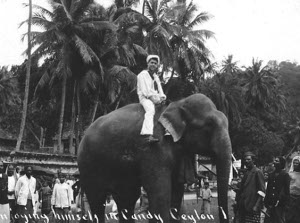![]() The Pacific War Online Encyclopedia
The Pacific War Online Encyclopedia
|
| Previous: Pacheco | Table of Contents | Next: Padang |

Naval
History and Heritage Command #NH 106122
Pack animals continued to be used during the Second World War wherever motor vehicles were in short supply or were unable to navigate the terrain. Horses and mules were widely used by the Japanese Army, which was far from fully motorized, but they were also used by the Allies in Burma. Elephants also saw use in Burma.
Horses were supplied to British officers in Burma, but these were used to carry personal effects rather than being ridden. A mule was capable of carrying up to 160 pounds of supplies or equipment, such as ammunition and dismantled light guns. Ironically, the feed corn for these beasts often had to be brought in by cargo aircraft, the most sophisticated form of transport in the 1940s.
Over 147 elephants were used by the British in their 1944 winter offensive. An elephant could not carry much more than a mule, but its strength (an elephant can lift a quarter ton with its trunk) allowed it to assist with bridge building and other demanding tasks. Slim relied heavily on river craft built from local timber hauled by elephants. Elephants could also live off the land better than horses or mules, although they sometimes ate their own camouflage. However, the beasts paid a high price: It is estimated that 4000 elephants died in Burma during the war, many from Allied strafing while in Japanese service.
The Japanese attempted to use Burmese oxen as pack animals during the U-Go offensive.
However, the Burmese traditionally used their oxen as draft animals
(pulling carts and plows) and the animals were unaccustomed to carrying
loads on their backs. As a result, the animals often stubbornly refused
to move, throwing the Japanese logistics into disarray. Of
the 12,000 horses and
mules, 30,000 oxen, and 1030 elephants the Japanese gathered to support
their offensive, only a few mules and most of the elephants survived.
The horses survived an average of 55 days and the mules survived an
average of 73 days.
The Chinese were extremely short on vehicles, but lacked the pack animals to make up the difference. Of the estimated 10,647 horses and 20,688 mules needed for twenty
Kuomintang divisions, only 6,206 horses and 4.351 mules were available
in 1935. Mortality rates were high, around 5% in 1936 and as high as 10% in some units.
References
The Pacific War Online Encyclopedia © 2008, 2010, 2012, 2015 by Kent G.
Budge. Index